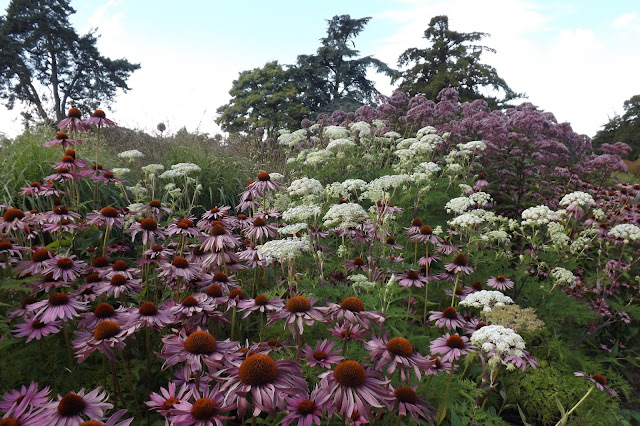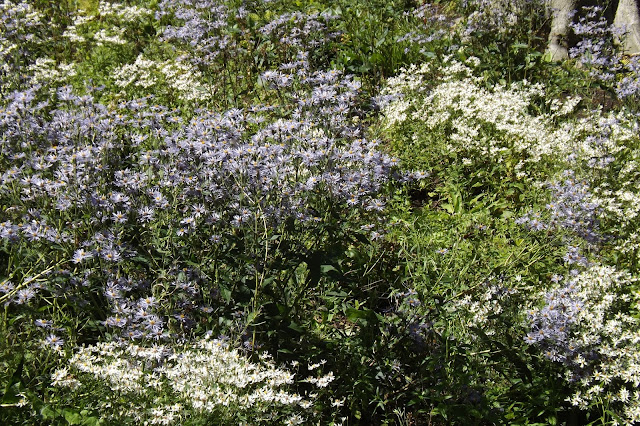A belated post about a visit to the National Trust property Arlington Court on our recent holiday in Devon in September. Two areas stood out for me on this visit, one was the hot border in the Victorian garden and the other was the walled kitchen garden. I always seem to find a walled garden on my holidays and this year I found two, more of the other one in a separate post.
There are two main gardens on this estate, a Victorian garden which leads then into the walled garden. The Victorian garden is as your might expect very formal with bedding and ornate climbing structures. There were lots of Senecio cineraria the silver leaved bedding plant and begonia's galore. Not really my thing, certainly of its time, but there was a fabulous border running along the right edge of the Victorian garden.
It was a fabulous example of a hot border, and certainly at its peak when we visited. But there was one glaring anomaly can you spot it on the view looking back across at it.
It was a fabulous example of a hot border, and certainly at its peak when we visited. But there was one glaring anomaly can you spot it on the view looking back across at it.
Yes a great big blowsy pale insipid Hydrangea right in the middle of this stunning border.
It was definitely the odd one out on this border that was otherwise zinging with colour and vibrancy. So lets ignore that and look a bit closer at the planting which was largely half-hardy annuals, Dahlias, Cannas and bedding. There were sunflowers, Tithonia, Salvias, Rudbeckias all jostling and mingling with vibrant, colour clashing joy.
This is a lovely combination, the true blue of Salvia patens with the big almost green-black leaves of the Ricinus communis (the castor oil plant) and at the bottom the cherry-pie scented Heliotrope with its dark purple flowers.
Then moving into a yellow medley.
There were some lovely Dahlia's
The butterflies were enjoying the single-flowered varieties.
There was one annual which I didn't recognise which looked like a nice flower for cutting with also interesting buds.
I've actually recently spotted this in the Chiltern seeds preview catalogue which popped through my door this week. Its called Hibiscus trionum 'Simply Love', what a lovely name. So that will be going in my order for next year's cutting patch I think.
You move into the walled garden from the Victorian garden and its a perfect site for growing vegetables.
 Covering one acre, it is south-facing and has good free-draining soil which they improve using seaweed from nearby Ilfracombe. They look to be pretty organic in their methods, using barrier methods to protect crops from pests, they rotate their crops to prevent any specific pest build-up and also to prevent exhaustion of nutrients from the soil. Where they do have pest problems they use organic methods of control such as insecticidal soaps and pheromone traps. They also encourage beneficial insects using companion planting and the placement of various bug hotels such as this fabulous one.
Covering one acre, it is south-facing and has good free-draining soil which they improve using seaweed from nearby Ilfracombe. They look to be pretty organic in their methods, using barrier methods to protect crops from pests, they rotate their crops to prevent any specific pest build-up and also to prevent exhaustion of nutrients from the soil. Where they do have pest problems they use organic methods of control such as insecticidal soaps and pheromone traps. They also encourage beneficial insects using companion planting and the placement of various bug hotels such as this fabulous one.
You could see the difference down in the south compared to my plot in Huddersfield with the squash, sprouts and other crops all at at an earlier stage than mine.
They had a few beds of flowers for cutting.
They had big areas for growing squashes and pumpkins.
Beautiful archways for apples and a lot of espaliers on the walls themselves,.
I was talking in my previous post about a bird 'pest' which was eating some of my crops. Here is the bird pest at Arlington, a little bit bigger, but I think it does cause a few problems eating the crops and grubbing up the soil. Beautiful though. Look at that blue, looking good against the glaucous blue of the leeks!
From here we went on a walk through the woods and came across so woolly creatures.
Some more bizarre than others.
There were owls, birds, bats, hedgehogs, mice, all shapes and sizes!
Some flowers too.
A lovely robin
These were the Woollen woods, which is a regular event I gather in the autumn. Where local knitters, crocheters and felters make some pieces for display on the trail much loved by kids.
This is a lovely combination, the true blue of Salvia patens with the big almost green-black leaves of the Ricinus communis (the castor oil plant) and at the bottom the cherry-pie scented Heliotrope with its dark purple flowers.
Then moving into a yellow medley.
There were some lovely Dahlia's
The butterflies were enjoying the single-flowered varieties.
There was one annual which I didn't recognise which looked like a nice flower for cutting with also interesting buds.
I've actually recently spotted this in the Chiltern seeds preview catalogue which popped through my door this week. Its called Hibiscus trionum 'Simply Love', what a lovely name. So that will be going in my order for next year's cutting patch I think.
You move into the walled garden from the Victorian garden and its a perfect site for growing vegetables.
 Covering one acre, it is south-facing and has good free-draining soil which they improve using seaweed from nearby Ilfracombe. They look to be pretty organic in their methods, using barrier methods to protect crops from pests, they rotate their crops to prevent any specific pest build-up and also to prevent exhaustion of nutrients from the soil. Where they do have pest problems they use organic methods of control such as insecticidal soaps and pheromone traps. They also encourage beneficial insects using companion planting and the placement of various bug hotels such as this fabulous one.
Covering one acre, it is south-facing and has good free-draining soil which they improve using seaweed from nearby Ilfracombe. They look to be pretty organic in their methods, using barrier methods to protect crops from pests, they rotate their crops to prevent any specific pest build-up and also to prevent exhaustion of nutrients from the soil. Where they do have pest problems they use organic methods of control such as insecticidal soaps and pheromone traps. They also encourage beneficial insects using companion planting and the placement of various bug hotels such as this fabulous one.You could see the difference down in the south compared to my plot in Huddersfield with the squash, sprouts and other crops all at at an earlier stage than mine.
They had a few beds of flowers for cutting.
They had big areas for growing squashes and pumpkins.
Beautiful archways for apples and a lot of espaliers on the walls themselves,.
I was talking in my previous post about a bird 'pest' which was eating some of my crops. Here is the bird pest at Arlington, a little bit bigger, but I think it does cause a few problems eating the crops and grubbing up the soil. Beautiful though. Look at that blue, looking good against the glaucous blue of the leeks!
From here we went on a walk through the woods and came across so woolly creatures.
Some more bizarre than others.
Some flowers too.
A lovely robin
These were the Woollen woods, which is a regular event I gather in the autumn. Where local knitters, crocheters and felters make some pieces for display on the trail much loved by kids.









































































